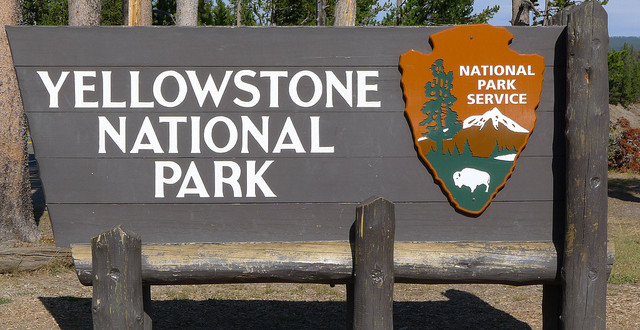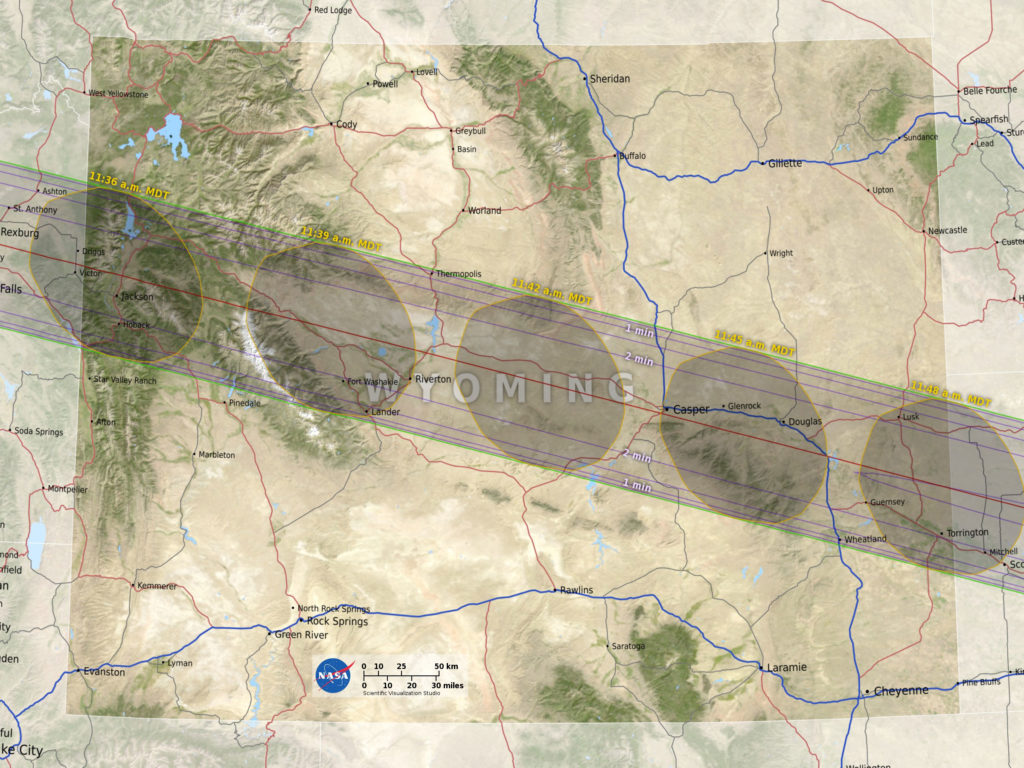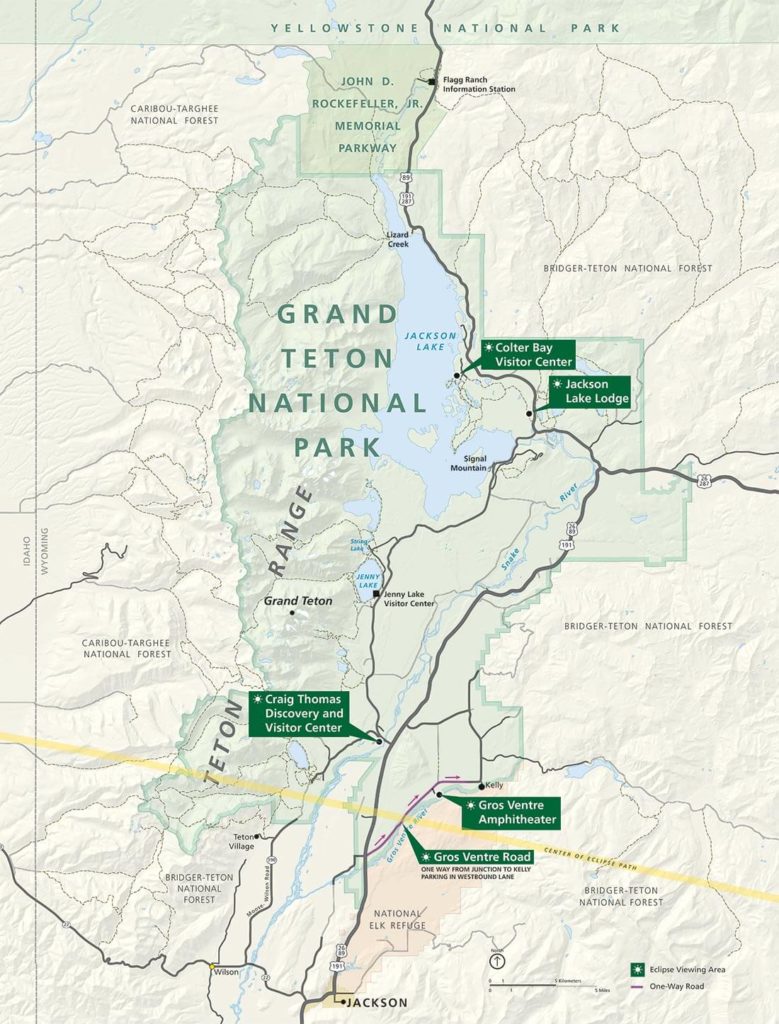Planning a visit to Yellowstone or Grand Teton National Parks to see the solar eclipse? Here are a few things to keep in mind.
According to NASA, the eclipse will pass over the United States Monday, August 21. It is slated to appear over the continental U.S. around 10 a.m. It will “peak” (enter total eclipse) over Grand Teton and Jackson at approximately 11:36 a.m. MST. A map of the eclipse’s path over Wyoming is below, courtesy of NASA.
Eclipse conditions will continue from 10 a.m. to 1 p.m.
According to a Yellowstone press release, officials are expecting a big turnout, even though Yellowstone isn’t in the path of total eclipse. Visitors will be able to see a partial eclipse from the park, while visitors in Grand Teton and Jackson will see a total eclipse.
If you want to pass through Yellowstone to get to Grand Teton, expect a line. Thankfully, officials decided to delay road sealing along the South Entrance route in anticipation of eclipse traffic; Grand Teton is predicting the eclipse will bring the largest number of visitors to the park in Grand Teton history.
Otherwise, visitors are cautioned to take the following precautions:
•Pack your patience
•Expect heavy traffic on park roads
•Give yourself plenty of time to travel to and from your destination
•Get up-to-date road conditions online and by phone at (307) 344-2117
•Do not expect to have cell phone service, even in areas where it is normally available
•Arrive with enough food, water, and fuel in your vehicle for the entire day
•Bring appropriate eclipse viewing glasses (available in park lodges, general stores, and bookstores) and solar filters for cameras, binoculars, or telescopes
•Read the solar eclipse frequently asked questions
In anticipation of visitor turnout, Grand Teton has prepared several Eclipse viewing areas where the phenomenon can be safely observed: Colter Bay Visitor Campground, Jackson Lake Lodge, the Craig Thomas Discovery and Visitor Center, Gros Ventre Amphitheater and along the Gros Ventre Road. You can see a map of the viewing areas above.
One thing to note about eclipse viewing: looking directly on a partial eclipse can severely damage your eyes. NASA has several tips for safe eclipse viewing, which you can read about below:
The only safe way to look directly at the uneclipsed or partially eclipsed sun is through special-purpose solar filters, such as “eclipse glasses” (example shown at left) or hand-held solar viewers. Homemade filters or ordinary sunglasses, even very dark ones, are not safe for looking at the sun; they transmit thousands of times too much sunlight. Refer to the American Astronomical Society (AAS) Reputable Vendors of Solar Filters & Viewers (link is external) page for a list of manufacturers and authorized dealers of eclipse glasses and handheld solar viewers verified to be compliant with the ISO 12312-2 international safety standard for such products.
Always inspect your solar filter before use; if scratched or damaged, discard it. Read and follow any instructions printed on or packaged with the filter.
Always supervise children using solar filters.
Stand still and cover your eyes with your eclipse glasses or solar viewer before looking up at the bright sun. After looking at the sun, turn away and remove your filter — do not remove it while looking at the sun.
Do not look at the uneclipsed or partially eclipsed sun through an unfiltered camera, telescope, binoculars, or other optical device.
Similarly, do not look at the sun through a camera, a telescope, binoculars, or any other optical device while using your eclipse glasses or hand-held solar viewer — the concentrated solar rays will damage the filter and enter your eye(s), causing serious injury.
Seek expert advice from an astronomer before using a solar filter with a camera, a telescope, binoculars, or any other optical device. Note that solar filters must be attached to the front of any telescope, binoculars, camera lens, or other optics.
If you are within the path of totality (https://go.nasa.gov/2pC0lhe (link is external)), remove your solar filter only when the moon completely covers the sun’s bright face and it suddenly gets quite dark. Experience totality, then, as soon as the bright sun begins to reappear, replace your solar viewer to look at the remaining partial phases.
Outside the path of totality, you must always use a safe solar filter to view the sun directly.
If you normally wear eyeglasses, keep them on. Put your eclipse glasses on over them, or hold your handheld viewer in front of them.
If you can’t get a pair of eclipse glasses, there are other ways of viewing the eclipse indirectly. NASA recommends making a pinhole projection by crossing your hands to make a waffle pattern and, with your back to the sun, watch the shadows through your hands. Otherwise, you can watch the shadow of a leafy tree.
 Yellowstone Insider Your Complete Guide to America's First National Park
Yellowstone Insider Your Complete Guide to America's First National Park









You must be logged in to post a comment.